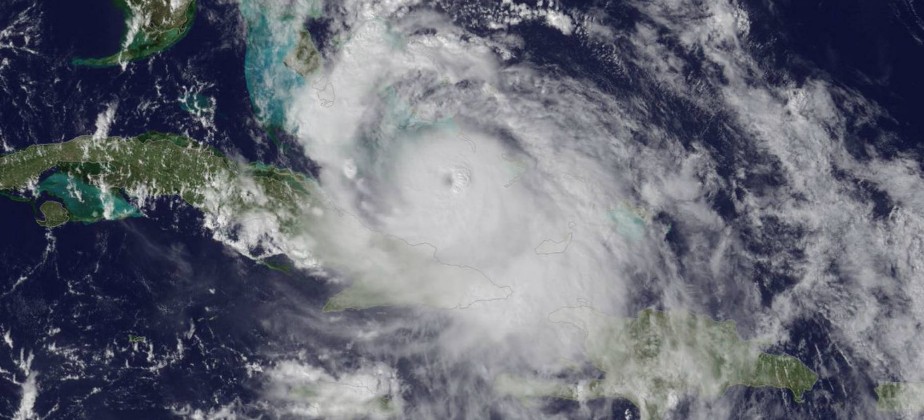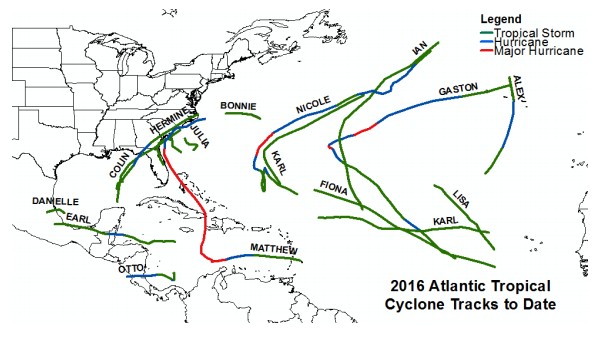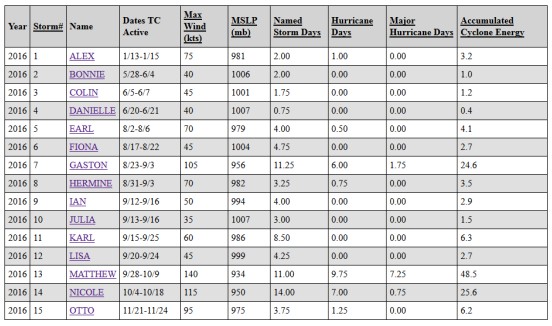Above-normal 2016 hurricane seasons

The Atlantic, eastern Pacific and central Pacific 2016 hurricane season have officially ended on November 30, and NOAA scientists said all three regions saw above-normal seasons.
For the Atlantic, this was the first above-normal season since 2012 with 15 named storms during 2016, including 7 hurricanes:
- Alex – January – The strongest January hurricane in Atlantic since records began in 1851
- Earl – August – Belize landfall, 40 people killed in Mexico
- Gaston – August – Formed during the peak of northern hemisphere's 2016 season
- Hermine – August/September – Made landfall in the Big Bend area, Florida
- Matthew – October – The strongest, deadliest and longest-lived storm of the season
- Nicole – October – Passed over Bermuda, remnants reached Greenland and Iceland
- Otto – November – The strongest Atlantic hurricane this late in the season since 1934
3 of them became major hurricanes: Gaston, Matthew and Nicole.
According to meteorologist Philip Klotzbach of the CSU, Matthew has generated the most Accumulated Cyclone Energy this season (48.5) and had many other meteorological achievements. It was followed by Nicole (25.6) and Gaston (24.6).

Atlantic basin tropical cyclone tracks in 2016. Credit: CSU

Observed 2016 Atlantic basin tropical cyclone activity. Credit: CSU
NOAA’s updated hurricane season outlook in August called for 12 to 17 named storms, including 5 to 8 hurricanes, with 2 to 4 of those predicted to become major hurricanes.
Five named storms made landfall in the United States during 2016, the most since 2008 when six storms struck. Tropical Storm "Bonnie" and Hurricane "Matthew" struck South Carolina. Tropical Storms "Colin" and "Julia", as well as Hurricane "Hermine", made landfall in Florida. Hermine was the first hurricane to make landfall in Florida since Wilma in 2005.
Several Atlantic storms made landfall outside of the United States during 2016: Tropical Storm "Danielle" in Mexico, Hurricane "Earl" in Belize, Hurricane "Matthew" in Haiti, Cuba, and the Bahamas, and Hurricane "Otto" in Nicaragua.
The strongest and longest-lived storm of the season was Matthew, which reached maximum sustained surface winds of 257 km/h (160 mph) and lasted as a major hurricane for eight days from September 30 to October 7. Matthew was the first category 5 hurricane in the Atlantic basin since Felix in 2007.
Matthew intensified into a major hurricane on September 30 over the Caribbean Sea, making it the first major hurricane in that region since Poloma in 2008. It made landfall as a category 4 major hurricane in Haiti, Cuba and the Bahamas, causing extensive damage and loss of life. It then made landfall on October 8 as a category 1 hurricane in the U.S. near McClellanville, South Carolina.
Matthew caused storm surge and beach erosion from Florida through North Carolina, and produced more than 254 mm (10 inches) of rain resulting in extensive freshwater flooding over much of the eastern Carolinas. The storm was responsible for the greatest U.S. loss of life due to inland flooding from a tropical system since torrential rains from Hurricane Floyd caused widespread and historic flooding in eastern North Carolina in 1999.
“The strength of Hurricane Matthew, as well as the increased number of U.S. landfalling storms this season, were linked to large areas of exceptionally weak vertical wind shear that resulted from a persistent ridge of high pressure in the middle and upper atmosphere over Caribbean Sea and the western Atlantic Ocean,” said Gerry Bell, Ph.D., lead seasonal hurricane forecaster at NOAA’s Climate Prediction Center. “These conditions, along with very warm Caribbean waters, helped fuel Matthew’s rapid strengthening.”
Eastern and central Pacific Hurricane Seasons
The eastern Pacific hurricane basin, which covers the eastern Pacific Ocean east of 140 degrees West, produced 21 named storms during 2016, including 11 hurricanes of which 5 became major hurricanes.
July through September was the most active three-month period on record for this basin. NOAA’s eastern Pacific hurricane season outlook called for 13 to 20 named storms, including 6 to 11 hurricanes, 3 to 6 of which were expected to become major hurricanes.
The central Pacific hurricane basin covers the Pacific Ocean west of 140 degrees West to the International Date Line. This basin saw seven tropical cyclones (includes tropical depressions and named storms) during 2016.
All seven became named storms, and included three hurricanes of which two were major hurricanes. Tropical Storm "Darby" made landfall on the Big Island of Hawaii, marking the first time in recorded history that two storms in three years struck the Big Island (Darby in 2016 and Iselle in 2014).
NOAA’s central Pacific hurricane season outlook called for 4 to 7 tropical cyclones. That outlook does not predict specific ranges of named storms, hurricanes and major hurricanes.
Analysis source: NOAA
See also:
Verification of 2016 Atlantic seasonal hurricane forecast from Colorado State University
Featured image: Hurricane "Matthew" – October 2016. Credit: NOAA/GOES

Commenting rules and guidelines
We value the thoughts and opinions of our readers and welcome healthy discussions on our website. In order to maintain a respectful and positive community, we ask that all commenters follow these rules.